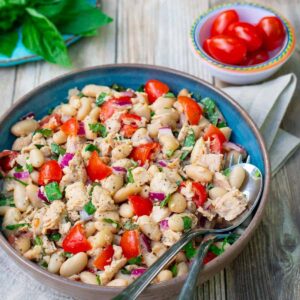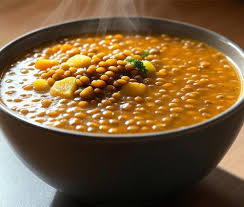Using Beans, Peas and Lentils Instead of Meat
go.ncsu.edu/readext?1069036
en Español / em Português
El inglés es el idioma de control de esta página. En la medida en que haya algún conflicto entre la traducción al inglés y la traducción, el inglés prevalece.
Al hacer clic en el enlace de traducción se activa un servicio de traducción gratuito para convertir la página al español. Al igual que con cualquier traducción por Internet, la conversión no es sensible al contexto y puede que no traduzca el texto en su significado original. NC State Extension no garantiza la exactitud del texto traducido. Por favor, tenga en cuenta que algunas aplicaciones y/o servicios pueden no funcionar como se espera cuando se traducen.
Português
Inglês é o idioma de controle desta página. Na medida que haja algum conflito entre o texto original em Inglês e a tradução, o Inglês prevalece.
Ao clicar no link de tradução, um serviço gratuito de tradução será ativado para converter a página para o Português. Como em qualquer tradução pela internet, a conversão não é sensivel ao contexto e pode não ocorrer a tradução para o significado orginal. O serviço de Extensão da Carolina do Norte (NC State Extension) não garante a exatidão do texto traduzido. Por favor, observe que algumas funções ou serviços podem não funcionar como esperado após a tradução.
English
English is the controlling language of this page. To the extent there is any conflict between the English text and the translation, English controls.
Clicking on the translation link activates a free translation service to convert the page to Spanish. As with any Internet translation, the conversion is not context-sensitive and may not translate the text to its original meaning. NC State Extension does not guarantee the accuracy of the translated text. Please note that some applications and/or services may not function as expected when translated.
Collapse ▲Black eyed peas, pinto beans, edamame, these are all legumes that are good sources of protein and can be a healthy substitute for meat. Having a meatless meal occasionally is good for your pocket book as they tend to be less expensive than some cuts of meat.
Legumes are a class of vegetable that include beans, peas and lentils. They are typically low in fat, contain no cholesterol, and are high in protein, folate, potassium, iron and magnesium. They are a good source of fiber which is beneficial because a diet high in fiber can reduce your risk of developing diabetes and help lower blood cholesterol levels, which can reduce your risk of heart disease.
Soybeans are one type of legume that contains all the amino acids needed to make a complete protein, just like meat. They also contain isoflavones, a plant-based compound that may reduce the risk of some types of cancer. Soybeans are grown on about 1.6 million acres in NC. Soybeans are the largest crop in North Carolina by acreage. Soybeans are grown in all 100 counties in North Carolina, but most are in the eastern part of the state. The leading counties for soybean production include Robeson, Beaufort, Pitt, Sampson, Pasquotank, Wayne, Duplin, and Johnston. In a good year, soybeans can be worth up to $800 million to NC farmers.
Edamame is a popular vegetable soybean. They are immature green soybeans found in the freezer section of your supermarket and can be steamed, boiled or microwaved and may be eaten as a snack or appetizer served at Asian restaurants.
Select, store and serve legumes for best nutrition. Select legumes with a deep, almost glossy color. Dry looking or faded legumes indicate a longer storage time. The longer legumes are stored, the more likely the legumes won’t taste fresh.
Store dried legumes away from heat, light and moisture. They keep well in an airtight container or sealed plastic bag. Store unopened canned beans and peas in a cool, dry place. They safely store for two to five years. Legumes canned at home keep up to a year.
When preparing legumes, sort and rinse carefully. Discard any small stones, fibers, or misshapen or discolored legumes you find in your bag.
Beans and other large, dried legumes such as chickpeas and black-eyed peas require soaking in water, to rehydrate them for even cooking. It is also thought that soaking reduces the flatulence inducing quality of legumes and makes them easier to digest.
Soak legumes overnight 24 to 48 hours. Then pour water off, add fresh water and they are ready to cook. If you forgot to soak them overnight, do a quick soak by placing them in water and bring to a boil for two minutes. Remove from heat, cover and let beans soak for an hour. Drain beans and discard soak water. Add fresh water and season.
If you need a small amount for a recipe, use canned legumes. They don’t require long simmering times, but may have a lot of sodium, so rinse well to remove any sodium added during processing.
Experiment with legumes by trying White Bean and Tuna Salad. It makes 2 servings, has 226 calories, 7 grams fat, 25 mg cholesterol, 470 mg sodium, 22 grams protein, 21 grams carbohydrates, and 8 grams fiber.
White Bean and Tuna Salad

White Bean and Tuna Salad
1 (4.5- 6-ounce) can tuna
1 (15-ounce) cans cannellini white beans, drained and rinsed
2 T capers, drained and rinsed
3 Tablespoons red wine vinegar
Black pepper, to taste
1/2 medium red onion, thinly sliced
1/2 cup cherry tomatoes
2 cups romaine lettuce
4 fresh basil leaves (optional)
Directions:
- In large bowl, add tuna, reserve olive oil in a separate bowl.
- With fork, break tuna into bite-size pieces.
- Add beans and capers.
- Into the bowl of olive oil, add the red wine vinegar. You should have 1 part vinegar to 2 parts oil, add more extra-virgin olive oil if necessary.
- Season with pepper.
- Pour dressing on tuna, bean and caper mixture and allow the flavors to infuse while slicing the vegetables.
- Add onion and tomatoes to tuna mixture and toss gently.
- Place the romaine on salad plates and top with tuna mixture. Tear fresh basil leaves over the top and serve immediately.
Easy Slow Cooker Sweet Potato Chili with Beans serves 6
Whether you’re meal prepping or making dinner for a crowd, this Sweet Potato Chili is a fuss-free, flavor-packed option that will leave everyone satisfied.

Easy Slow Cooker Sweet Potato Chili with Beans
1 large sweet potato, peeled and diced
1 bell pepper, chopped (any color)
1 medium onion, chopped
2 cloves garlic, minced
15 oz can black beans, drained and rinsed
15 oz can kidney beans, drained and rinsed
15 oz can diced tomatoes with their juices
15 oz can tomato sauce
1½ cups vegetable broth, or chicken broth for extra flavor
2 tbsp chili powder
1 tsp ground cumin
1 tsp smoked paprika
Salt, to taste
Black Pepper, to taste
Optional toppings: avocado slices, shredded cheese, sour cream, fresh cilantro, or sliced green onions
Directions:
- Add the diced sweet potato, bell pepper, onion, and minced garlic to the slow cooker.
- Pour in the black beans, kidney beans, diced tomatoes (with their juices), and tomato sauce.
- Sprinkle in the chili powder, ground cumin, smoked paprika, salt, and pepper. Pour the broth over everything and stir well to combine.
- Cover and cook on low for 6-8 hours or on high for 3-4 hours, until the sweet potatoes are tender.
- Once cooked, give the chili a good stir. Ladle into bowls and add your favorite toppings, such as avocado slices, shredded cheese, sour cream, cilantro, or green onions.
Nutritional information per serving: Calories: 220, Carbohydrates: 38g, Protein: 10g, Fat: 2g, Saturated Fat: 0.5g, Sodium: 500mg, Fiber: 9g, Sugar: 8g, Vitamin A: 12IU, Vitamin C: 40mg, Calcium: 80mg and Iron: 3mg.
Cozy Up: Immune-Boosting Lentil Soup Serves 4

Immune-Boosting Lentil Soup
Warm your soul and support your immune system with this nutrient-packed lentil soup. Perfect for chilly days, it’s loaded with wholesome ingredients like lentils, ginger, garlic, and vibrant veggies to keep you cozy and healthy boosting your immune system with every nourishing spoonful. It’s vegan, gluten-free, and oh-so-delicious!
1 tbsp olive oil
1 medium onion, finely chopped
2 medium carrots, diced
2 celery stalks, diced
3 garlic cloves, minced
1 tbsp fresh ginger, grated
1 tsp ground turmeric
1 tsp ground cumin
1 tsp smoked paprika
1 cup dried red lentils, rinsed
4 cups low-sodium vegetable broth
1 cup canned diced tomatoes (no salt added)
1 cup kale or spinach, chopped
1 medium sweet potato, diced
Juice of 1 lemon
Salt and black pepper to taste
Garnish with Fresh parsley or cilantro (optional)
Directions:
- Sauté the Aromatics: Heat olive oil in a large pot over medium heat. Add the onion, carrots, and celery. Cook for 5–7 minutes until softened.
- Add the Spices: Stir in garlic, ginger, turmeric, cumin, and smoked paprika. Cook for 1–2 minutes until fragrant.
- Incorporate Lentils and Base: Add the lentils, vegetable broth, diced tomatoes, and sweet potato. Bring to a boil, then reduce to a simmer. Cover and cook for 20–25 minutes, or until the lentils and sweet potato are tender.
- Finish with Greens and Lemon: Stir in the chopped kale or spinach. Simmer for 5 minutes until wilted. Add lemon juice, and season with salt and black pepper to taste.
- Serve and Enjoy: Ladle into bowls, garnish with fresh parsley or cilantro, and serve warm.
Nutritional Facts per serving: Calories: 250, Carbohydrates: 40g, Protein: 12, Fat: 4g, Saturated Fat: 0.5g, Sodium: 300mg, Potassium: 700mg, Fiber: 10g, Sugar: 8g, Vitamin A: 12000IU, Vitamin C: 40mg, Calcium: 90mg and Iron: 4mg.
Sources for this article NC Extension Food and Nutrition educational program. For more information about the Foods and Nutrition please contact Louise L. Hinsley, Extension Agent, Family Consumer Science at the Beaufort County Center of N.C. Cooperative Extension, 155 Airport Road, Washington, 252-946-0111.



